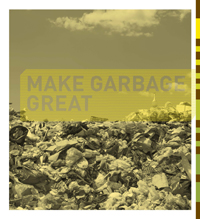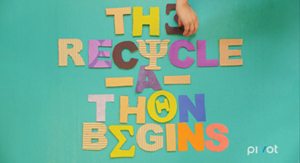Marketing on a Shoestring
“Ever the entrepreneur, Tom wanted to explore what else could be made from waste that others view as having no value,” says Albe Zakes, Global Vice President Communications for TerraCycle, Inc.
Thus, the TerraCycle concept behind its business model was born: If you could find a way to make high-quality affordable consumer products from waste, you could create a business with two revenue streams. In other words, get paid to collect material, and get paid for the resulting product or recycled commodity you create from that material.
With its business model in tact, and no ability to spend money on paid advertising, the company had to approach marketing in a unique way since the very early days.
Szaky explains, “Because we were a start-up with limited capital and razor thin margins, we simply couldn’t pay for ads or an outside agency to create our marketing. Instead we relied first on PR and effective media relations. Our story was incredibly media friendly: A college dropout builds million-dollar business on worm poop.”
With a PR team (of Zakes and interns), TerraCycle mastered the art of effective media outreach, which included research, e-mail and calling journalists, specializing its story to the media they were calling.
“We used our start-up story for business media. We focused on our sustainability with environmental media. And led with the efficacy and affordability of our products for garden and home magazines. These strategies led to huge amounts of media coverage: from the cover of Inc. Magazine to features in The New York Times and Better Homes and Gardens,” adds Zakes.
Over time TerraCycle had to find ways to rely less on PR and find other ways to market the company without spending much money. At first the PR team started down the path of content marketing by reaching out to editors with whom they had a strong working relationship, and pitch TerraCycle executive leaders as guest contributors and bloggers.
Zakes says, “This proved very successful. After all the pitch was an easy sell. We were offering high-quality, expert-level content, at no cost, and further offering to promote every post via our website, newsletter and social networks.”
All of this content creation, led TerraCycle to exploring a book deal and in 2009, Szaky was publishing his first book, Revolution in a Bottle (Portfolio, 2009). Since that time, Szaky and Zakes have published two more books, most recently a ‘coffee table book about garbage’ called, Make Garbage Great (HarperCollins, 2015).
The success of selling book deals then led TerraCycle to exploring TV deals as well.
“TerraCycle was a young, hip, innovative company full of passionate, stylish, goofy, outgoing employees all working in a graffiti-covered factory in Trenton, NJ. It seemed to us an obvious choice for a business-based docu-series,” says Zakes.
And TV networks agreed. In 2010, The National Geographic Channel ran a 4-part mini-series called Garbage Moguls all about TerraCycle. More recently, TerraCycle partnered with a new network called Pivot to produce a full reality series called, Human Resources. After a critically acclaimed Season 1, Season 2 aired during the Fall of 2015.
Zakes includes, “Each of these efforts – the blogs, the books and TV deals, themselves created more PR opportunities. Each called for PR campaigns, speaking tours, press conferences, and book signings — all of which helped to create revenue and awareness for TerraCycle.”
Zakes and Szaky like to call this method “Negative Cost Marketing.” First, TerraCycle looks for zero-cost ways to market the company. Then, it finds ways to generate revenue through marketing efforts.
“Efforts like the TV shows, books, speaking fees, and endorsement deals help market TerraCycle, but actually create more revenue than costs. Some years our marketing department is actually an independent profit center — not just a support function helping to driving profit via sales and business development. Even when we fall short, we offset the majority of our marketing costs via efforts that are still increasing our brand awareness,” explains Zakes.
Furthermore, the speed of the digital world is both an advantage and a challenge for the marketing teams at TerraCycle. Marketing will continue on its current path becoming ever more digital and ever more content driven. Advertising will continue to become impactful with consumers. Consumers are constantly becoming more adept at ignoring advertising, even as cable providers and websites become more forceful in getting advertising to consumers (via pop-ups, drop down banner ads or the automatic ads tacked onto YouTube videos, for example). Yet, consumers continue to outpace many of these advancements with pop-up blockers and manual work-arounds (hello mute button!).
Szaky reinforces, “Companies will have to learn how to build their marketing messages into genuine content, not pay to attach it to other’s content. The digital world also makes every tweet, every Facebook post, every ‘meme’, and every Vine a potential global phenomenon. So brands must be ready to manage, react and respond in effective, positive ways to any consumer, because every consumer now has the potential impact of an industry expert.”
Genuine content has been a strong suit for TerraCycle as it inked its latest TV deal: Each season generated 6-figure revenue deals and created valuable opportunities to integrate its partners into episodes.
Between two seasons, they were able to integrate some of their biggest partners – Capri Sun, Colgate, P&G, Garnier, The Naked Grape, GU, WellPet and others, at no cost to the brand – which created major ROI for partnerships. In addition, it drove massive consumer awareness of TerraCycle via online campaigns, TV/radio ads, outdoor advertising and much more that was funded by the network. It has also created fantastic employee engagement.
TerraCycle tracks ROI in a variety of manners. From a PR standpoint the team looks at unique media placements, media impressions and ad value equivalency. For social and digital they look at engagement, much more than raw followers or visitors per month. How long did they stay on our site? How much engagement (shares, comments, likes, retweets etc.) did the social post or blog create? These metrics really help them to see what is working and what is not, and are valued highly by brand partners.
Zakes and Szaky have had plenty moments of trial and error, and learning on the fly. Here they share their key learnings: “Today’s world — especially when it comes to digital media — is more and more global and homogenized. This means despite cultural differences, many strategies need only be tweaked, not changed entirely. In the developing world, where access to e-mail and the Internet is less wide spread, that certainly changes the platforms a company can use to reach consumers. But for most of the first world, methods may only need refining.
PR especially changes significantly market to market. In Brasil, no one leaves voicemails, so we stopped leaving them. In France, journalists do not want to be called on the phone (in the United States, many will tell you something similar), but it is an absolute non-starter in many European countries. In Japan, media is far more interested in attending press conferences then just receiving a pitch.
Communications strategies tend to change quite a bit as well. In both France and Canada we do far less direct outreach or e-mailing — even to those who are opted-in. Social media sees similar differences. Here in the United States, there is almost no limit to how much a company can post to Twitter and to a lesser extent on Facebook. But we found in Europe and some Pacific markets, we were getting negative feedback about our rates of posting, so we reduced accordingly.
Keep an open mind about where your story comes from and what platforms you use to reach consumers. I like to call our story creation strategy, ‘Supply Chain Mining’. We look for PR stories, blog posts, social media content up and down our business model. Any part of your business can be a marketing or storytelling opportunity – your factories, your employees, your products, your offices, your customers, your vendors and suppliers, your start-up story, almost anything!
Along those same lines, don’t pigeon hole the platforms and channels you target for PR and marketing. Just because it is not your core demographic or industry, doesn’t mean it can’t help to create general brand awareness. The old clich goes, ‘any PR is good PR’. Now that of course refers to even to negative press having some value, but we’ve co-opted the concept to mean an article in any magazine, newspaper or blog is a good thing, even if its not an obvious fit for your key demographics or business goals.”
TOOLS FOR SUCCESS
Suggestions for Free or Low Cost Marketing Technology and Tactics
- For monitoring media coverage: Google and Meltwater News.
- For researching media targets: Use online databases like Cision.
- Use any and every social media network out there to help power your content marketing, but also to research, connect and develop relationships with media, industry experts and associations.
- For global companies (like TerraCycle) with little T&E budget: utilize Skype and Join Me as free ways to connect, train, strategize and report with global teams.
BOOK REPORT
 TerraCycle’s new book, Make Garbage Great, published by HarperDesign is a 244-page hardback book that explores the past, present and future of waste, consumption, economics and recycling. This book exemplifies how to produce high quality, engaging, informative content that also helps to market TerraCycle’s business. The book only talks about TerraCycle a little, but shines a spotlight on the importance of its mission. Plus, TerraCycle allowed the book itself to focus on history, economics and even other companies and organizations, because it knew the PR and marketing around the book would create the value for the company that was needed. Read the book and sign up for its recycling programs!
TerraCycle’s new book, Make Garbage Great, published by HarperDesign is a 244-page hardback book that explores the past, present and future of waste, consumption, economics and recycling. This book exemplifies how to produce high quality, engaging, informative content that also helps to market TerraCycle’s business. The book only talks about TerraCycle a little, but shines a spotlight on the importance of its mission. Plus, TerraCycle allowed the book itself to focus on history, economics and even other companies and organizations, because it knew the PR and marketing around the book would create the value for the company that was needed. Read the book and sign up for its recycling programs!
A PERFECT MATCH
TerraCycle’s new reality TV show, Human Resources, was the result of several years of searching for the right network partner. When the company found Pivot, it was a match made in marketing heaven. Pivot is a network for Millennials and all viewers who are — or want to be become — socially responsible. It was launched by Participant Media, a movie production company responsible for films like An Inconvenient Truth, Super Size Me, Food Inc. and many other major documentaries.
ON A MISSION
TerraCycle’s mission is simple: Eliminate the Idea of Waste. The company creates innovative collection systems and recycling methods for waste otherwise considered non-recyclable. What is key to understand is that everything – from a scientific standpoint — can be recycled. What makes something non-recyclable is simply economics. If it costs more to collect and process the material than the resulting commodity is worth on the open market, companies call it non-recyclable. TerraCycle’s business model and processes enable it to overcome this antiquated equation.
